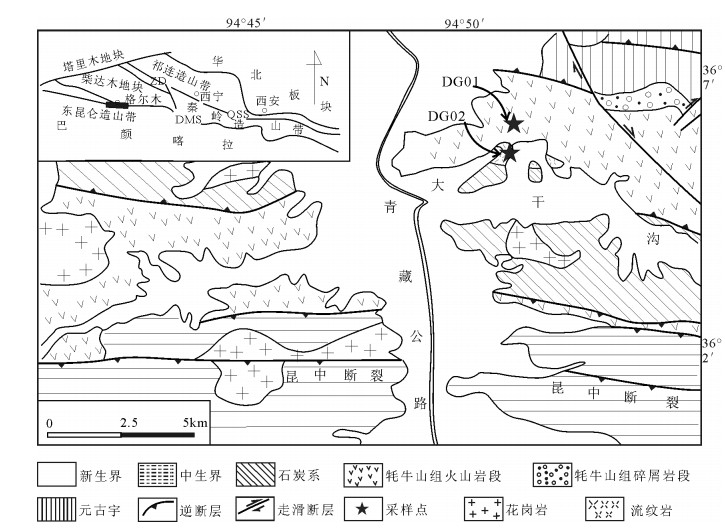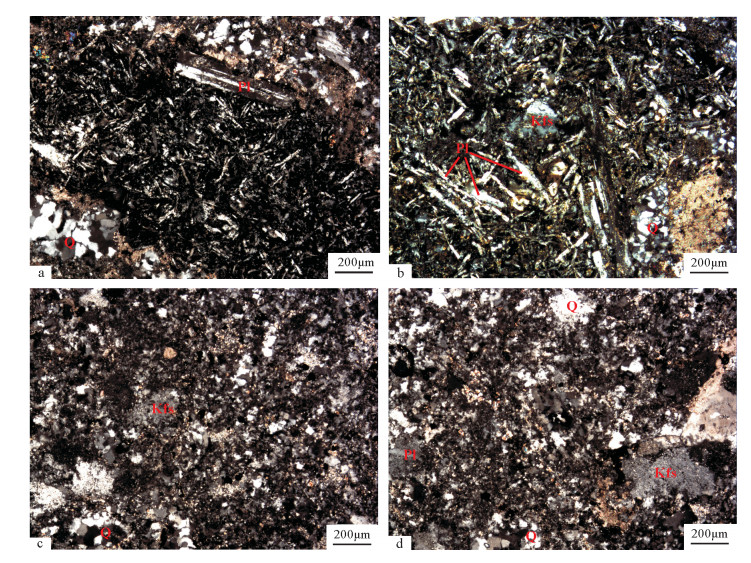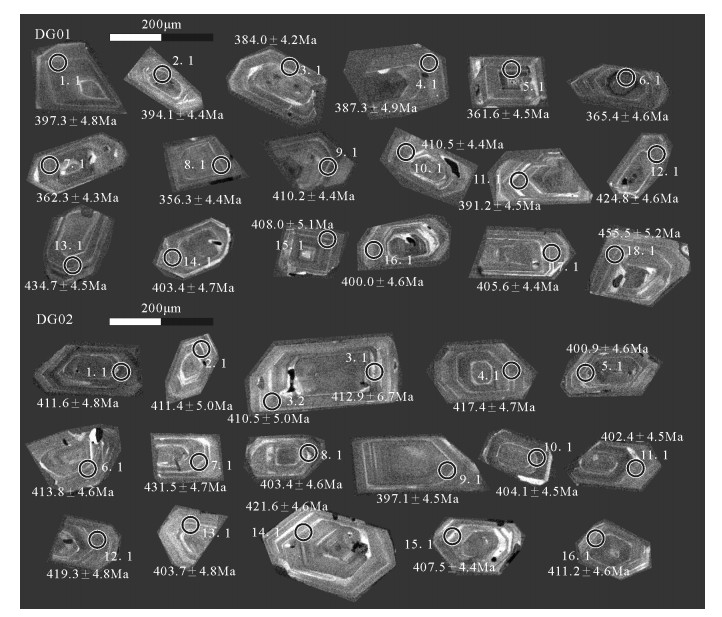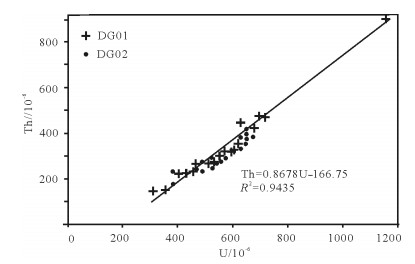SHRIMP zircon ages of the Dagangou volcanic rocks in the Eastern Kunlun orogenic belt and their implications
-
摘要:
东昆仑大干沟以北地区造山后形成的牦牛山组磨拉石建造不整合覆盖于前泥盆系之上,其形成时代对限定柴达木盆地加里东造山作用的结束时间及晚古生代裂解作用的开始时间具有重要意义。应用单颗粒锆石离子探针质谱仪(SHRIMP)方法,对牦牛山组上部火山岩段的样品进行精确的锆石U-Pb测年。结果表明,牦牛山组上段火山岩样品DG01和DG02中的岩浆锆石206Pb/238U平均年龄分别为403.6±5.1Ma和409±3.4Ma。综合前人研究认为,造山后牦牛山组伸展型磨拉石的形成时代为晚志留世-早泥盆世,限定了晚古生代裂解的开始时间,也意味着早古生代加里东造山运动在晚志留世-早泥盆世之前已经结束。
-
关键词:
- 东昆仑大干沟 /
- 火山岩 /
- SHRIMP锆石U-Pb年龄 /
- 早泥盆世 /
- 东昆仑造山带
Abstract:The Maoniushan Formation of molasse, formed in a post-orogenic environment in Dagangou area of the Eastern Kunlun Mountains, rests unconformably on pre-Devonian strata. Its formation time is critical for determining the terminal of the Caledonian orogeny and the initiation of splitting in the Late Paleozoic. The authors conducted zircon U-Pb dating for volcanic rocks of the Up-per Maoniushan Formation by SHRIMP. The samples(DG01 and DG02) of the Upper Maoniushan Formation yielded two average zircon U-Pb ages of 403.6±5.1Ma and 409±3.4Ma. Combined with the previous studies, the formation time of the Maoniushan For-mation should be Late Silurian-Early Devonian. This provides a constraint on the starting time of splitting in the Late Paleozoic and also means that the Caledonian orogeny ended before the Late Silurian-Early Devonian.
-
-
图 1 研究区地质略图及采样点位置(据参考文献[①]修改)
QSS—商丹缝合带;Zd—宗务隆构造带;DMS—东昆仑-勉略缝合带
Figure 1. Geological map of the study area showing sampling sites
图 5 大干沟火山岩锆石U-Th关系图解
(据参考文献[15]修改)
表 1 大干沟火山岩SHRIMP锆石U-Th-Pb同位素测定结果
Table 1 SHRIMP U-Th-Pb dating results for zircons from volcanic rocks in Dagangou area
样品 U/10-6 Th/10-6 Th/U 207Pb/206Pb ±% 207Pb/235U ±% 206Pb/238U ±% 206Pb/238U
年龄/Ma207Pb/206Pb
年龄/Ma样品DG01 DG01-1.1 358 181 0.52 0.054 2.7 0.475 3 0.064 1.2 397.3 4.8 378 62 DG01-2.1 577 323 0.58 0.056 1.8 0.486 2.2 0.063 1.2 394.1 4.4 447 40 DG01-3.1 680 421 0.64 0.055 2.5 0.465 2.8 0.061 1.1 384.0 4.2 411 56 DG01-4.1 313 143 0.47 0.054 3 0.457 3.2 0.062 1.3 387.3 4.9 353 67 DG01-5.1 553 288 0.54 0.055 3.6 0.434 3.9 0.058 1.3 361.6 4.5 392 82 DG01-6.1 401 223 0.57 0.057 2.4 0.459 2.7 0.058 1.3 365.4 4.6 496 53 DG01-7.1 518 265 0.53 0.054 2.2 0.426 2.5 0.059 1.2 362.3 4.3 348 51 DG01-8.1 524 270 0.53 0.051 3.2 0.396 3.4 0.059 1.3 356.3 4.4 219 73 DG01-9.1 717 471 0.68 0.055 1.7 0.496 2 0.066 1.1 410.2 4.4 403 37 DG01-10.1 630 445 0.73 0.055 1.8 0.501 2.1 0.066 1.1 410.5 4.4 422 41 DG01-11.1 433 225 0.54 0.054 2.2 0.468 2.5 0.065 1.2 391.2 4.5 382 49 DG01-12.1 697 472 0.7 0.056 2.3 0.529 2.6 0.068 1.1 424.8 4.6 463 51 DG01-13.1 1158 897 0.8 0.059 2.1 0.571 2.4 0.07 1.1 434.7 4.5 582 47 DG01-14.1 406 221 0.56 0.057 2.1 0.503 2.4 0.065 1.2 403.4 4.7 472 46 DG01-15.1 600 324 0.56 0.056 3.3 0.506 3.5 0.065 1.3 408.0 5.1 461 73 DG01-16.1 467 267 0.59 0.057 2 0.502 2.3 0.064 1.2 400.0 4.6 489 43 DG01-17.1 620 352 0.59 0.054 1.6 0.487 1.9 0.065 1.1 405.6 4.4 387 36 DG01-18.1 594 319 0.55 0.055 1.7 0.556 2.1 0.073 1.2 455.4 5.2 414 39 样品DG02 DG02-1.1 553 280 0.52 0.054 3.7 0.493 3.9 0.066 1.2 411.6 4.8 380 83 DG02-2.1 466 243 0.54 0.056 4.3 0.509 4.4 0.066 1.2 411.4 5 452 95 DG02-3.1 489 239 0.5 0.054 3.8 0.491 4.2 0.066 1.7 412.9 6.7 366 86 DG02-3.2 386 230 0.61 0.059 2.7 0.531 3 0.066 1.3 410.5 5 552 59 DG02-4.1 650 395 0.63 0.053 2 0.487 2.3 0.067 1.2 417.4 4.7 322 45 DG02-5.1 528 256 0.5 0.056 2.3 0.497 2.6 0.064 1.2 400.9 4.6 460 52 DG02-6.1 626 339 0.56 0.056 2.8 0.514 3 0.066 1.1 413.8 4.6 462 62 DG02-7.1 665 389 0.61 0.058 3.8 0.557 4 0.069 1.1 431.5 4.7 543 83 DG02-8.1 530 271 0.53 0.056 1.9 0.502 2.2 0.065 1.2 403.4 4.6 468 42 DG02-9.1 488 267 0.56 0.056 2.2 0.491 2.5 0.064 1.2 397.1 4.5 456 49 DG02-10.1 567 294 0.54 0.056 2.5 0.495 2.7 0.065 1.2 404.1 4.5 434 55 DG02-11.1 567 292 0.53 0.058 1.7 0.517 2.1 0.064 1.1 402.4 4.5 536 37 DG02-12.1 634 386 0.63 0.055 2.4 0.511 2.6 0.067 1.2 419.3 4.8 418 53 DG02-13.1 382 180 0.49 0.056 3.3 0.498 3.5 0.065 1.2 403.7 4.8 450 73 DG02-14.1 651 410 0.65 0.053 2.5 0.498 2.8 0.068 1.1 421.6 4.6 347 57 DG02-15.1 647 357 0.57 0.055 1.9 0.491 2.2 0.065 1.1 407.5 4.4 395 43 DG02-16.1 529 279 0.55 0.055 2.2 0.497 2.5 0.066 1.2 411.2 4.6 401 50 -
潘裕生,周伟明,许荣华,等. 昆仑山早古生代地质特征与演化[J]. 中国科学(D辑),1996,26(4):302-307. 张雪亭,杨生德.青海省区域地质概论[M].北京:地质出版社,2007:36-39. 陆露,吴珍汉,胡道功,等.东昆仑牦牛山组流纹岩锆石U-Pb年龄及构造意义[J].岩石学报,2010,26(4):1150-1158. 张传林,叶现韬,李怀坤.新疆塔里木北缘新元古代最晚期岩浆事件[J].地质通报,2014,33(5):606-613. 张耀玲,胡道功,石玉若,等.东昆仑造山带牦牛山组火山岩SHRIMP锆石U-Pb年龄及其构造意义[J].地质通报,2010,29(11):1614-1618. 张耀玲,张绪教,胡道功,等.东昆仑造山带纳赤台群流纹岩SHRIMP锆石U-Pb年龄[J].地质力学学报,2010,16(1):21-27. 张亚峰,裴先治,丁仨平,等.东昆仑都兰县可可沙地区加里东期石英闪长岩LA-ICP-MS锆石U-Pb年龄及其意义[J].地质通报, 2010,29(1):79-83. 周春景,胡道功,吴珍汉,等.东昆仑三道湾流纹英安斑岩锆石U-Pb年龄及其地质意义[J].地质力学学报,2010,16(1):28-35. Black L P,Kamo S L,Allen C M,et al.Improved 206Pb/238U micro-probe geochronology by the monitoring of a trace-element-related matrix effect;SHRIMP,ID-TIMS,ELA-ICP-MS and oxygen isotope documentation for a series of zircon standards[J].Chemical Geology,2004,205(1):115-140. Black L P,Kamo S L,Allen C M,et al.Improved 206Pb/238U micro-probe geochronology by the monitoring of a trace-element-related matrix effect;SHRIMP,ID-TIMS,ELA-ICP-MS and oxygen isotope documentation for a series of zircon standards[J].Chemical Geology,2004,205(1):115-140.
Claesson S,Vetrin V,Bayanova T,et al. U-Pb zircon ages from a Devonian carbonatite dyke,Kola peninsula,Russia:a record of geological evolution from the Archaean to the Palaeozoic[J]. Lithos, 2000,51:95-108. Claesson S,Vetrin V,Bayanova T,et al. U-Pb zircon ages from a Devonian carbonatite dyke,Kola peninsula,Russia:a record of geological evolution from the Archaean to the Palaeozoic[J]. Lithos, 2000,51:95-108.
Compston W,Williams I S,Meyer C.U-Pb geochronology of zircons from lunar breccia 73217 using a sensitive high mass-resolution ion microprobe[J].Journal of Geophysical Research:Solid Earth(1978-2012),1984,89(S02):B525-B534. Compston W,Williams I S,Meyer C.U-Pb geochronology of zircons from lunar breccia 73217 using a sensitive high mass-resolution ion microprobe[J].Journal of Geophysical Research:Solid Earth(1978-2012),1984,89(S02):B525-B534.
Steiger R H,Jäger E. Subcommission on geochronology:convention on the use of decay constants in geo-and cosmochronology[J]. Earth and planetary science letters,1977,36(3):359-362. Steiger R H,Jäger E. Subcommission on geochronology:convention on the use of decay constants in geo-and cosmochronology[J]. Earth and planetary science letters,1977,36(3):359-362.
Vavra G,Schmid R,Gebauer D. Internal morphology, habit and U-Th-Pb microanalysis of amphibolite-to-granulite facies zircons:geochronology of the Ivrea Zone(Southern Alps)[J]. Contri-butions to Mineralogy and Petrology, 1999, 134(4):380-404. Vavra G,Schmid R,Gebauer D. Internal morphology, habit and U-Th-Pb microanalysis of amphibolite-to-granulite facies zircons:geochronology of the Ivrea Zone(Southern Alps)[J]. Contri-butions to Mineralogy and Petrology, 1999, 134(4):380-404.
吴元保,郑永飞.锆石成因矿物学研究及其对U-Pb年龄解释的制约[J].科学通报,2004,49(16):1589-1604. 陈道公,Deloule E,倪涛. 大别地体新店榴辉岩变质锆石U-Pb年龄和氧同位素研究[J].中国科学(D辑),2005, 35(8):691-699. Anthi L,Dieter G. Constraining the prograde and retrograde PT-t path of Eocene HP rocks by SHRIMP dating of different zircon domains:inferred rates of heating,burial,cooling and exhumation for central Rhodope,northern Greece[J].Contributions to Mineral-ogy and Petrology, 1999,135:340-354. Anthi L,Dieter G. Constraining the prograde and retrograde PT-t path of Eocene HP rocks by SHRIMP dating of different zircon domains:inferred rates of heating,burial,cooling and exhumation for central Rhodope,northern Greece[J].Contributions to Mineral-ogy and Petrology, 1999,135:340-354.
Claesson S, Vetrin V, Bayanova T, et al. U-Pb zircon ages from a Devonian carbonatite dyke,Kola peninsula,Russia:a record of geological evolution from the Archaean to the Palaeozoic[J]. Lithos, 2000, 51:95-108. Claesson S, Vetrin V, Bayanova T, et al. U-Pb zircon ages from a Devonian carbonatite dyke,Kola peninsula,Russia:a record of geological evolution from the Archaean to the Palaeozoic[J]. Lithos, 2000, 51:95-108.
Pidgeon R T, Nemchin A A, Hitchen G J.Internal structures of zircons from Archaean granites from the Darling Range batholith:Implications for zircons stability and the interpretation of zircon UPb ages[J]. Contributions to Mineralogy and Petrology,1998,132:288-299. Pidgeon R T, Nemchin A A, Hitchen G J.Internal structures of zircons from Archaean granites from the Darling Range batholith:Implications for zircons stability and the interpretation of zircon UPb ages[J]. Contributions to Mineralogy and Petrology,1998,132:288-299.
青海省地质矿产局. 青海省岩石地层[M]. 武汉:中国地质大学出版社,1992:104-111. 李荣社,计文化,赵振明,等. 昆仑早古生代造山带研究进展[J]. 地质通报,2007,26(4):373-381. 许志琴,杨经绥,李海兵,等. 造山的高原——青藏高原地体的拼合、碰撞造山及隆升机制[M]. 北京:地质出版社,2007:1-458. 李继亮,孙枢,郝杰,等. 碰撞造山带的碰撞事件时限的确定[J].岩石学报,1999,15(2):315-320. 陈守建,李荣社,计文化,等. 昆仑造山带晚泥盆世沉积特征及构造古地理环境[J]. 大地构造与成矿学,2007,31(1):44-51. 刘彬,马昌前,郭盼,等. 东昆仑中泥盆世A型花岗岩的确定及其构造意义[J].地球科学,2013,38(5):947-962. 青海省地质矿产局.中华人民共和国区域地质调查报告——格尔木市幅(J-46-[35]) (1∶ 20万) .1982.




 下载:
下载:




